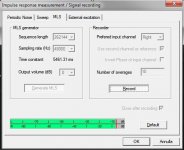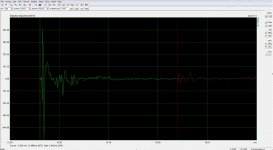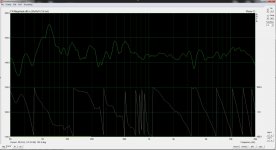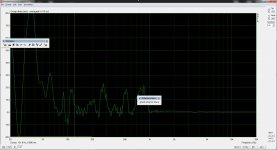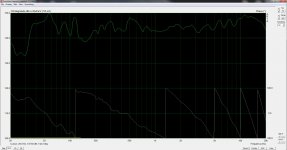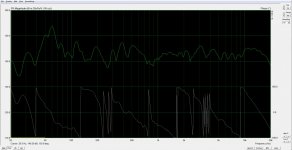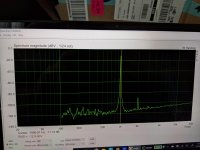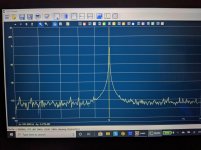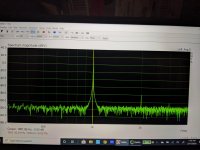Just a quick update. My old multimeter was a large part of the problem. With the Steinberg UR22mkII I was able to get what I think is good calibration with the loopback in ASIO the control panel turned off. DAW/Input knob turned all the way to DAW. Inputs turned all the way down full stop...which I thought was odd the inputs still pass signal but makes it repeatable, so I'm happy about that.
Assuming I have the inputs and outputs calibrated correctly...Would I be correct to also assume that if I adjust any of the input or output levels from the sound card, that the calibration is now not valid? If this is true, what is the best way to adjust levels when taking measurements?
I am a rookie in measuring,
I add somes measure,
From listening point and microphone ears height.
I use a Beringer ECM8000, preamp and Realtek high definition audio integrate in motherboard.
The question is,
What happen in the region from 700 to 1khz?
Can ignore that? Or i have to consider a correction.
Tell me your thoughts all adivices welcome.
The speaker is a dipole.
Thanks
I add somes measure,
From listening point and microphone ears height.
I use a Beringer ECM8000, preamp and Realtek high definition audio integrate in motherboard.
The question is,
What happen in the region from 700 to 1khz?
Can ignore that? Or i have to consider a correction.
Tell me your thoughts all adivices welcome.
The speaker is a dipole.
Thanks
Attachments
It looks like reflections. But depends on where you are doing your measurements and obviously what the response of the speaker is normally. 1/time window will give you the lowest reliable frequency...but generally speaking I find that is still a bit optimistic. How far way are you measuring from? What is the closest boundary? Being a di-pole makes it even more complex. I use a lot of ground plane measurements to help give me a longer window. Just a few things to consider.
It looks like reflections. But depends on where you are doing your measurements and obviously what the response of the speaker is normally. 1/time window will give you the lowest reliable frequency...but generally speaking I find that is still a bit optimistic. How far way are you measuring from?
2.6 meter
Wall back 1.4 meter, side wall 4 meter, but the room is not regular and the speakers aren't not positioned symmetricall respect the side walls, the room is big, in listening position the back wall is at 4 meter.What is the closest boundary?
i tried to limit the speaker irregular lateral time reflection with a triangle speakers position for listening in near field.
I had chosen the windows at the first reflection, what time do you suggest?Being a di-pole makes it even more complex. I use a lot of ground plane measurements to help give me a longer window. Just a few things to consider.
If your microphone is 2.6 meters away and your back wall is 1.4 meters away...there is a very strong possibility that you are getting a strong reflection from the back wall... especially since you are di-pole...if you double the distance to the back wall, it is 2.8m...almost the same distance as your microphone. If you are trying to get the response of the room and the speaker together than it doesn't matter, but if you are trying to get just the speaker alone...you might try moving the microphone closer (1 meter) and putting some blankets/pillows on the floor between the mic and the speaker. Your floor bounce is most likely your first reflection. I would suspect your first reflection in the measurements you have shown are right after the 14ms mark.
Ok thanks, tomorrow i repeat the measure, but a simple question, if i not measure in a listen position i not know what arrive at my ears or not?If your microphone is 2.6 meters away and your back wall is 1.4 meters away...there is a very strong possibility that you are getting a strong reflection from the back wall... especially since you are di-pole...if you double the distance to the back wall, it is 2.8m...almost the same distance as your microphone. If you are trying to get the response of the room and the speaker together than it doesn't matter, but if you are trying to get just the speaker alone...you might try moving the microphone closer (1 meter) and putting some blankets/pillows on the floor between the mic and the speaker. Your floor bounce is most likely your first reflection. I would suspect your first reflection in the measurements you have shown are right after the 14ms mark.
I can not move the speakers..
If you just want the sound of the speakers at the listening position the you may want to use the RTA function. Or don't use any gating on your impulse response and run the measurement to take the average of 10 to 20 averages...then apply smoothing.
Naw...easy. I'm new to ARTA also but it will take the averages for you. Just set it up as before. Tell it to run 20 cycles. Then apply some smoothing after.
Yes, i was currently use 10 averages.
The work will be to make the new measurements and compare from different situation, from listen position with and without absorbent on the floor, and at 1 meter.
The work will be to make the new measurements and compare from different situation, from listen position with and without absorbent on the floor, and at 1 meter.
I tried....
Ergo,
I tried to follow the directions you posted, at least up until adjusting the amplifier to output 2.83v (i.e. Step 4). However - I still can't get the mic to produce accurate SPL reading. I even have a "Sound Level Calibrator".
I used the formula provided in your PDF (i.e. 10^(dbgain/20)) - which in my case approximated 0.63 = 10^(-4db/20) <--because -4db corresponds to the lowest setting when the input gain knob on the Focusrite 2i2 is turned alway the way down.
What is interesting is, (after following your instructions through Step 3), I get accurate SPL reading when I'm in the Tools-->Third Octave SPL and Loudness --->Generate Pink Noise. When I do this and hold an SPL meter right next to the mic - the measured response in ARTA and the measured response on my SPL meter are spot on (+/- 1db).
However, when I'm in impulse response mode --> Single-gated smoothed frequency response/spectrum - the graphed SPL is about 10db higher.
Is there something obvious I'm doing wrong?!?
Dkalsi, I've attached a step by step I wrote down at some point after I had struggled a bit with figuring out the same problem.
Ergo,
I tried to follow the directions you posted, at least up until adjusting the amplifier to output 2.83v (i.e. Step 4). However - I still can't get the mic to produce accurate SPL reading. I even have a "Sound Level Calibrator".
I used the formula provided in your PDF (i.e. 10^(dbgain/20)) - which in my case approximated 0.63 = 10^(-4db/20) <--because -4db corresponds to the lowest setting when the input gain knob on the Focusrite 2i2 is turned alway the way down.
What is interesting is, (after following your instructions through Step 3), I get accurate SPL reading when I'm in the Tools-->Third Octave SPL and Loudness --->Generate Pink Noise. When I do this and hold an SPL meter right next to the mic - the measured response in ARTA and the measured response on my SPL meter are spot on (+/- 1db).
However, when I'm in impulse response mode --> Single-gated smoothed frequency response/spectrum - the graphed SPL is about 10db higher.
Is there something obvious I'm doing wrong?!?
Hi Erik,Naw...easy. I'm new to ARTA also but it will take the averages for you. Just set it up as before. Tell it to run 20 cycles. Then apply some smoothing after.
so you were right, the 1 meter measurement has a regular phase.
Listening point 2,60 meter and 1 meter.
Attachments
Hi Erik,
so you were right, the 1 meter measurement has a regular phase.
Listening point 2,60 meter and 1 meter.
Cool. It's fun to see how different mic positions change the response of a speaker. As an audiophile I get so focused on how it has to be this way or it has to be that way, but in the end there are so many variables outside our system that effect the sound...sometimes it's just better to sit back and know it will never be perfect and enjoy the music. Enjoy!
I am trying also to calibrate ARTA. I am trying to get a 1KHz signal to match the reading I get in Clio Pocket. Using Clio Pocket as the source. I see that using spectrum in ARTA the it is always smoothing at least 1/24th. With out setting Clio to 1/24 smoothing there is about a 10-12 dB difference using dBV scale for both. When I set Clio to 1/24 smoothing I am about 1or 2 dBV off. If I do an impulse measurement of the same signal is closer. I have attached a few pics. What I am unclear on is, once calibration is done, wouldn't adjusting levels on the sound card throw off calibration? Shouldn't ARTA have some way of controlling level from within? I see it can go as low as -20 dB for some measurements but in my system for spl measurements that isn't enough attention? I am not an electronics expert and don't have much experience using scopes. Mostly just acoustics.
Attachments
Last edited:
Thanks and enjoy to you.Cool. It's fun to see how different mic positions change the response of a speaker. As an audiophile I get so focused on how it has to be this way or it has to be that way, but in the end there are so many variables outside our system that effect the sound...sometimes it's just better to sit back and know it will never be perfect and enjoy the music. Enjoy!
my speaker sounds pretty good, i have been optimizing the crossover for 2 years.
it's amazing how every time after an improvement the sound increases the resolution of the recording content and this allows us to understand that something can still be done to improve.
the development of an audio system is a path made of stages, like a Matryoshka, every time you solve a problem that leads to a great improvement of the sound new information appears that before you didn't know it existed, it's like the matryoshka until you remove the top layer you don't see what's underneath.
Arta feeding ClioPocket 1k sin at 1V and ClioPocket feeding Arta 1k sin at 1V...I'm assuming since they are both reading the same I have Arta calibrated properly? I did this with inputs on the Steinberg UR22MKII turned down all the way and Output gain turned up all the way. I did this so it is easy to keep calibration set( I don't have to recalibrate it I bump a gain knob). I was surprised that it still passes signal with inputs turned down all the way. But it seems to work.
Attachments
Last edited:
You can't possibly be calibrated correctly. You're showing 40dbV for a 0dbV sine input.Arta feeding ClioPocket 1k sin at 1V and ClioPocket feeding Arta 1k sin at 1V...I'm assuming since they are both reading the same I have Arta calibrated properly?
Dave.
Sorry looking at it I can see how you would think that. I have cursors set as close to ok as I could get. If you look at the bottom left of each screen they are reading -2.5ish dBV. The cursors make it look like it's at 40dBV.
Last edited:
